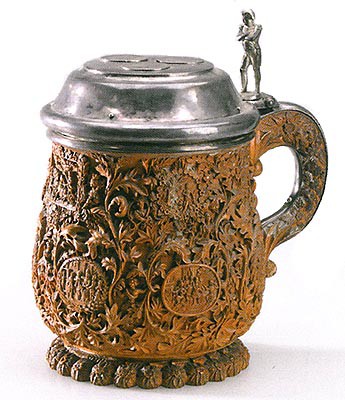After the death of Napoleon III, the empress Eugénie and the Prince Imperial spent their summers at the Château d'Arenenberg, on the banks of Lake Constance. Following the defeat, this “realm of memory” had become a hub for Bonapartists, a safe place where supporters could meet and commemorate the 15 August anniversary without fear of persecution.
In 1878, before arriving in Switzerland, Eugenie and her son spent time travelling around Europe. The empress returned to Bad Ems to take the waters, while the Prince Imperial journeyed north into Scandinavia. There he spent four days in Copenhagen before setting off on a tour of Sweden and Norway. In Stockholm, he was received at the court of King Oscar II, on the throne since 1872 and grandson of Maréchal Jean-Baptiste Bernadotte. During his stay, the king presented the Prince Imperial with this beer tankard. The young man, who afterwards joined his mother in Arenenberg, took the gift with him. This was to be his last sojourn in Switzerland. The tankard thus remained at the château and is today held in the Napoleonmuseum Thurgau's collections.
The outer layer of the tankard is made of sculpted boxwood, decorated with leaves and flowers. The floral pattern is interwoven with figures in mediaeval costume. Around the perimeter are a number of oval and rectangular lockets inlaid with historical scenes, possibly featuring Bernadotte. The handle is also decorated using the floral motif. The lip, handle inlays and lid are all made of silver. The lid is inset with three silver thalers bearing the portraits of Karl XIV Johan (Jean-Baptiste Bernadotte), Oscar I and Karl XV. Pushing back on the silver figure of Napoleon I opens the tankard's lid. The figure, with his arms crossed, resembles the one in the painting, Napoléon à Sainte-Hélène (external link in French) by François Joseph Sandmann.
The mug is lined with vermeil and can hold about a litre of liquid. The underside of the lid is inlaid with three lockets featuring three coats of arms and their dates: 1834, 1856 and 1861.
Christina Egli (tr. H.D.W.)
Curator, Napoleonmuseum Thurgau, Château and Parc d'Arenenberg, Salenstein
May 2010
Beer tankard decorated with Napoleonic scenes

- Date :
- 1878
- Technique :
- Sculpted boxwood, silver and vermeil
- Place held :
- Salenstein, Napoleonmuseum Thurgau, Château et Parc d'Arenenberg
- Photo credit :
- © Napoleonmuseum Thurgau - Daniel Steiner

